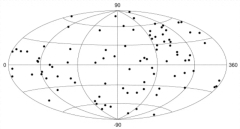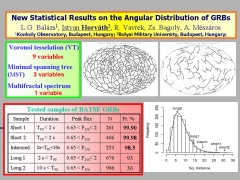|
|
Anisotropy of the sky distribution
Separating the GRBs into short and long subclasses, it is shown that the short ones are distributed anisotropically, but the long ones seem to be distributed still isotropically. The character of anisotropy suggests that the cosmological origin of short GRBs further holds, and there is no evidence for their Galactical origin. It is also argued that this anisotropy cannot be caused exclusively by instrumental effects due to the nonuniform sky exposure of BATSE instrument
|
|

|
Angular distribution of the intermediate subclass
The counts-in-cells test eliminates the nonuniform sky-exposure function of the BATSE instrument. Applying this method to the case of all gamma-ray bursts, we found no intrinsic nonrandomness. The intrinsic randomness for intermediate gamma-ray bursts, however, is rejected on the 96.4% confidence level.
|
|

|
Randomness in the sky-distribution
To investigate the eventual non-randomness in the subsamples, we defined 13 test variables (nine from the Voronoi tesselation, three from the minimal spanning tree and one from the multifractal spectrum). Assuming that the point patterns obtained from the BATSE subsamples are fully random, we made Monte Carlo simulations taking into account the BATSE's sky-exposure function. We concluded that the short1 and short2 groups deviate significantly (99.90 and 99.98 per cent, respectively) from the full randomness. The intermediate group also gives a significant deviation (98.51 %).
|


